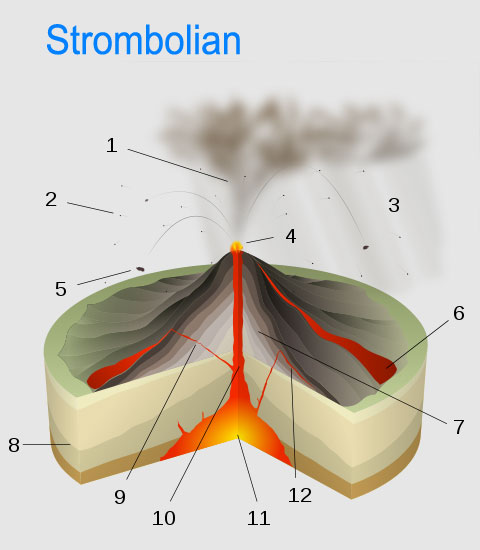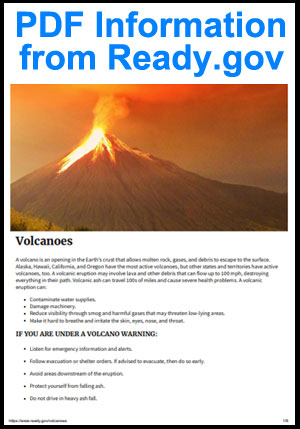Supervolcano / Volcanos
When a volcano erupts, size matters. A small eruption might release some gas and steam before quieting down again. Larger eruptions could have lava pour out and damage areas nearby. But the largest eruptions that come from supervolcanoes are so large and disruptive; they're expected to kill tens of thousands of people if one erupted in our lifetime.
To measure how explosive a volcanic eruption is, vulcanologists use a scale known as VEI. That stands for Volcanic Explosivity Index. The smallest eruptions come in a VEI 0 classified as "Hawaiian." It typically has an outpouring of lava on the ground and a plume height under 100 meters. Eruptions of this type are happening all the time in places around the world.
Each step up the scale from VEI 2 is ten times greater than the previous one. (The first two on the scale don't fit into that quite as neatly. A VEI 0 shoots out less than ten thousand cubic meters of ejecta, and a VEI 1 kicks out more than ten thousand but less than one million cubic meters of ejecta.)
That means a VEI 2 has an ejecta volume of one million cubic meters, while a VEI 3 has an ejecta volume of ten million cubic meters. So a supervolcano would kick out a mind-boggling one trillion cubic meters of ejecta.
Within 10 miles of a supervolcano eruption, you would have ash that's tens or even hundreds of feet deep. 300 miles away, the ash would be several inches deep, suffocating plants, animals and bodies of water it fell upon.
Warning Signs
The first indicator of a supervolcano like Yellowstone getting ready to erupt would be the ground rising. The entire caldera could potentially rise 10 feet into the air. Swarms of earthquakes would begin, and distinctive waveforms would appear on the seismographs.
As these signs appear, an area extending 200 miles out in every direction from the center would have to be evacuated. Just before the eruption, the earthquakes would start giving out a long continuous vibration. This is known as a harmonic tremor, and it's one of the last things to happen before the eruption begins.
Here's a comparison of the various types of volcanoes and their effects.
DEFINITIONS:
- Ejecta is the stuff that's kicked out of a volcano.
- Tephra is another word for volcanic material, as scoria, dust, etc., ejected during an eruption.
- > Means greater than.
- < Means less than.
- > Means greater than or equal to.
Hawaiian
| VEI | Classification | Ejecta in Cubic Meters | Plume Height in Meters | Description |
| 0 | Hawaiian | 10,000 or Less | < 100 | Effusive |
| Ash Thickness | Ash Thickness | |
| 10 Miles | 300 Miles | How Frequent Are Eruptions |
| Nil | Nil | Continuous |

Hawaiian eruption: 1, ash plume; 2, lava fountain; 3, crater; 4, lava lake; 5, fumarole; 6, lava flow; 7, layers of lava and ash; 8, stratum; 9, sill; 10, magma conduit; 11, magma chamber; 12, dike
Image from © Sémhur / Wikimedia Commons
Strombolian
| VEI | Classification | Ejecta in Cubic Meters | Plume Height in Meters | Description |
| 1 | Strombolian | > 10,000 | 100 - 1,000 | Gentle, Non-Explosive |
| Ash Thickness | Ash Thickness | |
| 10 Miles | 300 Miles | How Frequent Are Eruptions |
| Dusting | Nil | Daily |

Strombolian eruption: 1: ash plume, 2: lapilli, 3: volcanic ash fall, 4: lava fountain, 5: volcanic bomb, 6: lava flow, 7: layers of lava and ash, 8: stratum, 9: dike, 10: magma conduit, 11: magma chamber, 12: sill
Image from © Sémhur / Wikimedia Commons
Vulcanian
| VEI | Classification | Ejecta in Cubic Meters | Plume Height in Meters | Description |
| 2 | Vulcanian | > 1,000,000 | 1,000 - 5,000 | Small, Explosive |
| Ash Thickness | Ash Thickness | |
| 10 Miles | 300 Miles | How Frequent Are Eruptions |
| Fraction of an Inch | Nil | Weekly |

Vulcanian eruption: 1 ash plume, 2 lapilli, 3 lava fountain, 4 volcanic ash fall, 5 volcanic bomb, 6 lava flow, 7 layers of lava and ash, 8 stratum, 9 sill, 10 magma conduit, 11 magma chamber, 12 dike
Image from © Sémhur / Wikimedia Commons
Vulcanian / Peléan / Sub-Plinian
| VEI | Classification | Ejecta in Cubic Meters | Plume Height in Meters | Description |
| 3 | Vulcanian / Peléan / Sub-Plinian | > 10,000,000 | 3,000 - 15,000 | Moderate, Catastrophic |
| Ash Thickness | Ash Thickness | |
| 10 Miles | 300 Miles | How Frequent Are Eruptions |
| Few Inches | Dusting | Few Months |

Peléan eruption: 1 Ash plume, 2 Volcanic ash fall, 3 Lava dome, 4 Volcanic bomb, 5 Pyroclastic flow, 6 Layers of lava and ash, 7 Stratum, 8 Magma conduit, 9 Magma chamber, 10 Dike
Image from © Sémhur / Wikimedia Commons
Peléan / Plinian / Sub-Plinian
| VEI | Classification | Ejecta in Cubic Meters | Plume Height in Meters | Description |
| 4 | Peléan / Plinian / Sub-Plinian | > 100,000,000 | 10,000 - 25,000 | Moderate to Large, Cataclysmic |
| Ash Thickness | Ash Thickness | |
| 10 Miles | 300 Miles | How Frequent Are Eruptions |
| 1 Foot | 1/4 Inch | > 1 Year |

Plinian eruption: 1: ash plume, 2: magma conduit, 3: volcanic ash fall, 4: layers of lava and ash, 5: stratum, 6: magma chamber.
Image from © Sémhur / Wikimedia Commons
Peléan / Plinian
| VEI | Classification | Ejecta in Cubic Meters | Plume Height in Meters | Description |
| 5 | Peléan / Plinian | > 1,000,000,000 | 20,000 - 35,000 | Large, Paroxysmic |
| Ash Thickness | Ash Thickness | |
| 10 Miles | 300 Miles | How Frequent Are Eruptions |
| 2 Feet | 1/2 Inch | > 10 Years |
Plinian / Ultra-Plinian
| VEI | Classification | Ejecta in Cubic Meters | Plume Height in Meters | Description |
| 6 | Plinian / Ultra-Plinian | > 10,000,000,000 | > 30,000 | Very Large, Colossal |
| Ash Thickness | Ash Thickness | |
| 10 Miles | 300 Miles | How Frequent Are Eruptions |
| 10 Feet | 1 Inch | > 100 Years |
Ultra-Plinian
| VEI | Classification | Ejecta in Cubic Meters | Plume Height in Meters | Description |
| 7 | Ultra-Plinian | > 100,000,000,000 | > 40,000 | Super-colossal |
| Ash Thickness | Ash Thickness | |
| 10 Miles | 300 Miles | How Frequent Are Eruptions |
| Tens of Feet | Several Inches | > 1,000 Years |
Supervolcanic
| VEI | Classification | Ejecta in Cubic Meters | Plume Height in Meters | Description |
| 8 | Supervolcanic | > 1,000,000,000,000 | > 50,000 | Mega-colossal |
| Ash Thickness | Ash Thickness | |
| 10 Miles | 300 Miles | How Frequent Are Eruptions |
| Unknown | Unknown | 10,000 - 50,000 Years |
Volcano

Supervolcanoes 101 | National Geographic
What are supervolcanoes, and how catastrophic can they be? Learn how supervolcanoes form, where supervolcanoes are located, and how their destructive capabilities can make way for new life.
Yellowstone: Big Volcano Ready to Erupt | How the Earth Was Made (S1, E8) | Full Episode | History
Yellowstone National Park is one of the most dangerous geological features on Earth. In trying to uncover the processes behind Yellowstone's main attractions geologists came to a frightening realization, in Season 1, Episode 8, "Yellowstone." #HowTheEarthWasMade
Past and Present Threats
Supervolcanos are scary, but they're also relatively rare events. The last one to explode was at Toba in Sumatra about 71,000 years ago. Scientists discovered a genetic bottleneck in human evolution. It's thought the effects of the supervolcano on global climate killed off all but about 5,000 people. The worldwide effects of blotting out the sun's rays potentially brought humanity close to extinction.
There are still active supervolcanos, but none of them show any signs of erupting in the foreseeable future. If one did, past eruption sizes can't be used to predict how large future eruptions would be. The odds of one turning into a world-ending monster are vanishingly small. In the last 36 million years, only 42 eruptions were big enough to be classified as a VEI 8 or high 7.
While supervolcanos are rare, regular volcanos can pose a genuine threat, depending on where you live. Here are the steps you can take to protect yourself.
Preparation - Survival
Click Here for information on what to do from the United States government website, Ready.gov.
Click Here for the Red Cross Volcano Preparedness Information.
Click Here to download a PDF file with information on what to do from the United States government website, Ready.gov.
Return to 101 Ways to Die Home Page
This information is presented to make people aware of the larger world around them. If you can prepare for something as devastating as this, you're much more likely to be ready for smaller disruptions. Be aware and prepare.
4/15/2020
Updated 2/22/2022



